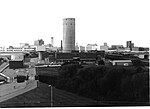London Motor Museum
2012 establishments in EnglandAutomobile museums in EnglandMuseums established in 2012Museums in the London Borough of HillingdonTransport museums in London ... and 1 more
Use British English from August 2015
The London Motor Museum had more than 160 exhibits; they included classic cars from the 1960s, 1970s and 1980s, and a selection of famous cars – including Herbie the Volkswagen Beetle, one of six original Batmobiles used in the first Batman (1989) film, and a Ford Gran Torino from the television series Starsky & Hutch. The museum closed down permanently in June 2018 after a dispute with the local council over business rates. The vehicles have now been moved to other museums across the UK.
Excerpt from the Wikipedia article London Motor Museum (License: CC BY-SA 3.0, Authors).London Motor Museum
Nestle's Avenue, London Hayes (London Borough of Hillingdon)
Geographical coordinates (GPS) Address Nearby Places Show on map
Geographical coordinates (GPS)
| Latitude | Longitude |
|---|---|
| N 51.501972 ° | E -0.42072 ° |
Address
Nestle's Avenue
Nestle's Avenue
UB3 4QG London, Hayes (London Borough of Hillingdon)
England, United Kingdom
Open on Google Maps










